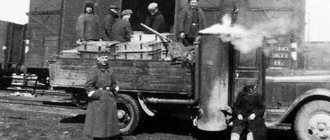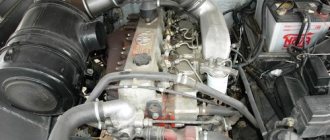change of terms
The updated Renault Master, which premiered last spring at the commercial vehicle exhibition in Birmingham, as one would expect, arrived in Russia in a different configuration. what is the difference? We looked for the answer to this question while driving a van assembled at the Renault Sovab plant in Batilly, France.
text: Mikhail Ozherelev / photo: Ekaterina Volkova / 07/31/2015
Renault Master MY2014. Gross weight: 3500 kg. Start of sales: end of 2014 Price: from RUB 1,469,000.
“Just don’t go into the city center,” the manager of the press park warned us, handing over documents for the car. “We haven’t had time to issue the pass yet.” Indeed, our new ward has a total weight of 3.5 tons, exactly under the upper bar of category B, which means he is banned from free driving in the center of Moscow. Well, let's not take any risks. Moreover, we are not limited in choosing a route.
The cabin interior of the updated Renault remains virtually unchanged
We got the Renault Master all-metal van in front-wheel drive, with an average wheelbase (3682 mm), average roof height (1820 mm) and, most interestingly, a four-door cargo compartment. Let us immediately note that the optional left sliding door, for which you will have to pay 20 thousand rubles, can significantly facilitate loading/unloading, for example, in a warehouse or in a narrow yard filled with cars.
Massive two-piece mirrors provide a wide view
With a cargo volume of 13.5 m3, this Master is capable of taking on board 1105 kg of cargo. Sliding door openings with a width of 1250 mm allow standard Euro pallets to be loaded from the side, and the loading height of 180 mm does not create inconvenience during loading/unloading. The photographer and I personally saw this when we stuffed large boxes of household appliances into the Master. What else is good to say about the cargo area? The rear doors open 270 degrees, and powerful magnets are provided to secure the doors. The wide rear sill is also optimized for loading and unloading operations, and the walls and floor of the cargo area are carefully lined with plywood.
The “big brother” of the well-known French heel Renault Kangoo in Russia first appeared on our market in 2011. And he immediately gained increased interest thanks to his extravagant appearance. The sloping hood, the radiator grille resembling a giant razor blade, the same monumental, vertically positioned headlights - because of these design solutions, the Master stood out effectively in the traffic flow.
In the 2014 model year version, the car received a new hood and radiator grille. Thanks to the fresh grille design, the front end of the new Master is in line with the updated Renault corporate identity, and the enlarged emblem, which has moved from the hood to the top of the grille, has become a distinctive element of all cars of the brand.
The driver's seat is equipped with a suspension system
But the interior of the cabin of the updated Renault remained virtually unchanged. The driver and passenger areas are designed in a manner typical of the French design school: the sensual curves of a two-tone center console with a huge number of compartments and niches are complemented by a set of non-standard layout solutions - for example, the placement of alarm and door lock buttons in the ceiling panel. The hooks for outerwear on the partition have not disappeared either - there are four of them, as before. However, there is still something new - for example, a USB connector, which was successfully placed near the pocket for a mobile phone.
The tested Renault Master has a three-seater cabin. The middle back of the passenger sofa can easily be transformed into a fixed table. At the same time, the seats themselves are French soft and have an anatomically correct profile. Wide door handles, which act as armrests, come in handy here. The driver's seat, adjustable in height and tilt, is equipped with a suspension system and lumbar support, which is rare for cars of this class. It's comfortable behind the wheel. The dashboard does not glare in the sun, and the three-spoke steering wheel, which is optimal in girth and pleasant to the touch, has a sufficient range of height adjustments.
The rear doors open 270 degrees, and powerful magnets are provided to secure the doors.
On the move, the 6-meter van, equipped with a reasonably sufficient 125-horsepower turbodiesel with a peak thrust of 310 Nm, is quite dynamic. For reference: models supplied to Russia are equipped with a modern Renault M9T diesel engine of Euro-4 standard in two power options - 125 and 150 hp. pp., both paired with a manual gearbox. If you actively work with the 6-speed manual, acceleration cannot be called sluggish. And if you follow the switching point prompts on the dashboard, you can achieve significant savings - in our case, the average fuel consumption in the combined cycle with a payload of about 500 kg was only 7.5 l/100 km. In this situation, given that the fuel tank capacity is 100 liters, you can travel more than 1000 km on one fill-up.
The optional left sliding door can make loading/unloading much easier
Handling in highway mode is flawless: the tall, long van does not sway and confidently holds its trajectory. Smooth ride is achieved thanks to clearly selected characteristics of the suspensions - rear leaf spring and front spring. Those who decide to move from the asphalt onto the dirt surface should be careful: the clearance under the rear axle beam, due to its special design, is very small.
The updated Master has received a number of new active safety elements, including the latest generation of Electronic Stability Control (ESC) with Adaptive Load Control as standard, as well as Hill Start Assist and Emergency Brake Assist ( Emergency Break Assist), electronic traction control system (Extended Grip). When ordering a vehicle complete with a trailer hitch, a stability control system (Trailer Swing Assist) is offered.
Plywood floor with friction coating
If we talk about safety when maneuvering in city crowds and cramped courtyards, it is worth mentioning the massive external two-section “mug” mirrors - the visibility through them is excellent. The panoramic lower quadrant expands the visibility range while minimizing blind spots. On top of that, on the updated Renault Master model, the sun visor on the passenger side can be supplemented with a mirror to improve visibility and increase safety. In this case, the visibility area from the driver's seat becomes even larger.
The rear suspension uses leaf springs
Nevertheless, moving in reverse on the Master, as well as on any of its “classmates,” is not a pleasant maneuver and requires appropriate skills. Correct orientation facilitates glazing in the rear doors and partition. Plus, the list of options includes rear parking sensors. You can order it for only 10 thousand rubles. The rather large turning diameter (14.1 m) can also cause some difficulties when driving in courtyards and alleys. However, in approximately the same way, in several steps, most of the Renault Master’s rivals have to turn around in urban cramps.
Cars supplied to Russia are equipped with a Renault M9T diesel engine (Euro-4)
Driving in the dark confirmed the high performance of the headlights. Low and high beams provide the driver with a sufficient understanding of the road situation, depending on the circumstances. The adaptive lighting mode makes its contribution to safety - illumination of the right or left side of the road as the car moves, depending on the turn of the steering wheel. It’s a pity that the basic configuration does not include daytime running lights. This is a minus.
Summarizing our impressions of the new Renault Master, we note that this car successfully combines convenience, efficiency and performance. And further. Taking into account the increased interest of Russians in the Master 2010 model year (model sales growth in 2013 compared to 2012 exceeded 100%), there is reason to believe that with the change of generations of the car, the company will be able to continue expansion into the Russian market, even despite the general decline LCV market.
NOTE
PRACTICAL.
To fix the spare wheel in the rear overhang, such a mechanism is provided.
CONTROVERSIAL.
The neck of the washer reservoir is poorly located; when refilling, it is better to use a funnel.
- Good visibility, spacious cargo compartment, increased driver comfort
- No daytime running lights as standard
| Specifications | |
| Wheel formula | 4x2 |
| Curb weight, kg | 2395 |
| Total weight, kg | 3500 |
| Useful volume of cargo compartment, m 3 | 13,5 |
| Cargo compartment dimensions, mm | 1400x1500x650 |
| Fuel tank volume, l | 100 |
| Engine | |
| type | diesel, 4-cylinder, Euro-4 |
| working volume, cm 3 | 2298 |
| power, l. With. at min -1 | 125 at 3500 |
| torque, Nm at min -1 | 310 at 1500 |
| Transmission | mech., 6-speed |
| Suspension | |
| front | independent, spring |
| back | dependent, spring |
| Brakes | disk |
| Tire size | 225/65R16 |
| PRICE | |
| Basic, rub . | 1 469 000 |
| Tested car, rub. | 1 754 400 |
| SERVICE | |
| Factory warranty | 2 years unlimited mileage |
| Mileage between services, km | 15 000 |
| COMPETITORS | |
| Citroen Jumper, Iveco Daily, Fiat Ducato, Ford Transit, Mercedes-Benz Sprinter, Peugeot Boxer, Volkswagen Crafter | |
IN PASSING
The new generation of Master is presented in Russia in two versions - van and chassis. The wide range of chassis includes versions with front or rear wheel drive, with a single or double cab, and you can also choose three lengths and payloads - from 1425 to 2420 kg. The vehicle is available in seven chassis versions, cabins for three or seven seats and various body options: manufactured goods and isothermal vans, flatbed, workshop, tow truck, etc. In addition, Russian manufacturers are converting cars with all-metal bodies into route and tourist buses, cash-in-transit vehicles , refrigerated vans.
A large number of modifications and a reasonable price starting from RUB 1,469,000, as well as programs specially developed by Renault for corporate clients, can become additional incentives for potential buyers to choose Renault Master, the company believes.
The car was provided by Renault Russia.
“Master” from Renault is a fairly large model range of light-duty cargo vans and trucks. This car is very widely known in European countries, including the UK. These cars are also known under the Opel Movano brand. However, the model was developed entirely by French engineers. Let's see what kind of cars they are and analyze what reviews the owners leave about the Renault Master.
First generation of “Master”
This version has been in development for several years. The debut took place in 1980. Initially, this modification was equipped with a Fiat-Sofim diesel engine. Its volume was 2.4 liters. Then another one was added to the range of engines - a 2.1-liter unit. Since 1984, the manufacturer began to equip the model with gasoline engines. These are 2 and 2.2 liter engines.
Among the features that were present in the first generations are unique door handles. They were distinguished by their rounded shape - the same handles could be seen on the Fiat Ritmo. The side door had a sliding design. Then the right to manufacture this model was transferred. The release was organized at Renault production sites, but then it was moved to SoVab sites.
The design of the Renault Master was unattractive even for a commercial vehicle. The body shapes and lines were angular, the headlights were rectangular in shape, and the grille had a traditional, classic appearance. The car was not at all aesthetically pleasing.
Demand for the car was low, but later panel vans began to gain consumer attention. An additional advantage of these modifications is that the compartment is quite large in size to accommodate cargo. The cars were intended for commercial use, and the consumer liked the large amount of luggage space. But even despite this, the debut version lost to similar cars from Fiat.
Second generation
It was 1997, and Renault Master was presented in its second version in France. A year later, it was recognized as “the best truck of the year.” The car received an original appearance and the main features by which it is recognized today.
The second version became much more attractive, and the appearance was very similar to the European one. The front part featured a large bumper with space for fog lights. The hood has more rounded lines, the headlights were now larger, and the emblem bisected the grille.
The assembly took place in the north-eastern part of France. It must be said that the build quality was at a high level. Reviews confirm this more than once. The range of engines has expanded - for example, diesel units G-Type, YD, Sofin 8140 have been added. As for the transmission system, a 5-speed manual transmission has been installed. There was also a six-speed manual transmission.
In 2003, the model underwent a global restyling. As a result, the body design has improved significantly. Its outlines became softer, the headlights increased in size. The model has become very similar to the Renault Traffic.
Third version
This model was shown to the world in 2010. It was released under several names at once. The design has been seriously revised. It featured large head optics and a luxurious bumper. The front part is distinguished by the presence of clear lines. The appearance of the car has become more reliable and solid.
The overall dimensions were increased - this led to an increase in the useful volume to 14.1 m3. The thresholds have been specially optimized to make the loading and unloading process easier and more convenient. As for engines, this includes units whose power is about 100-150 horsepower.
In 2020, they presented a special version of the new Renault Master, equipped with increased ground clearance, bottom and differential protection. Later, French developers showed an all-wheel drive version.
Now the car is very popular in a variety of areas of commercial activity. The Renault Master cargo van is especially popular.
Overall dimensions, ground clearance
In order to maximize the functionality of the bodies, engineers presented several versions of the bodies, differing in length and height. There were also several options for the location of partitions inside the body.
The short wheelbase version was 5048 mm long and 2070 mm wide. The height of this modification ranged from 2290 to 2307 millimeters. The ground clearance was unchanged for any version and was 185 millimeters. In reviews of the Renault Master, owners indicate that this ground clearance is quite sufficient for most tasks.
A car with a medium wheelbase had a length of 6198 mm, and models with a long wheelbase had a length of 6848 mm. At the same time, the length of the wheelbase ranged from 3182 to 4332 millimeters. The turning radius ranges from 12.5 to 15.7 m.
The maximum load capacity of the Renault Master, depending on the body, could range from 909 to 1609 kilograms. In this case, the total curb weight was from 2800 to 4500 kg. The luggage compartment had a volume from 7800 to 15,800 liters.
New Renault Master (2010 - present)
The third generation, without waiting for patents to be sold, launched in three forms at once: Movano, Nissan NV400 and Renault Master itself. The entire range of these exclusively commercial vehicles now corresponds to the appearance of all Renault bodies: clear lines of the façade, teardrop-shaped headlights, a massive bumper... The solidity and reliability of the car is emphasized by the protection of the body panels located at the rear and front, and the lighting technology continues the Renault line drawn across the entire model row.
More on the topic: Man TGX 680 – a powerful representative of the TGX family
Trying to expand the functionality of the body, Renault engineers built the car in several versions at once: 3 variations in length, 3 in height, plus several ways to arrange internal partitions and use various sliding structures. In the short version, the car has a length of 5048 mm and a width of 2070 mm. The height ranges from 2290 to 2307 mm. The wheelbase is the same: 3182 mm. Ground clearance: 18.5 cm.
New Renault Master 2014
You can give your car even more individuality by choosing the sidewall option: regular or glazed with different colors. Regardless of this choice, the van will not lose its useful volume, and in the maximum version it is 14.1 cubic meters. m. The thresholds of the machine are also optimized for loading and unloading operations.
The interior of the car indicates that this is exclusively a workplace. The two leather substitutes offered in Renault Master (“Yourte” and “Vague”) are fully consistent with his idea and modern trends in automotive design. In everything you can see an attempt to create a practical and comfortable interior: the gear shift lever is integrated into the front console. The place where the lever was previously located opens a passage into the cargo compartment.
The new steering wheel has an excellent balance of applied force and control accuracy: 0.67 daN over the entire operating range (previously, the force was 0.9 daN in the operating range). The engineers abandoned the four-spoke design in favor of a modern power steering steering wheel. To reduce the effort on the steering wheel, the steering rack has been changed, and the amplifier pump itself is made using modern technologies.
Test drive, video Renault Master 2014:
Only heated and ventilated front row seats come standard, but air flows at four speeds. Recirculation with dust protection allows you to create comfortable conditions for both driver and passenger. The latter’s chair, by the way, transforms into a table with stands for dishes. Adjustment of ventilation and heating has more than half a dozen positions, and the position of the driver's seat, as well as its shape, are adjustable in several parameters.
More on the topic: JAC trucks: typical representatives of the Chinese automobile industry
The noise insulation of the new Renault Master is not bad for a truck: the manufacturer’s stated limit of penetrating noise of 66.5 dB(A) (at speeds up to 50 km/h) works by 90 percent. When driving at a speed of 90 km/h, up to 71.9 dB(A) is declared. . 130 km/h - maximum 80.2 dB(A). For some time, these figures were considered the best for the European market, which confirms the statement of Renault representatives that noise insulation was taken into account during the body design process.
Technical characteristics of Renault Master
The same power unit is offered for all names and versions: M9T - 2.3-liter L4 diesel engine. However, various settings allow you to get from 99 to 148 hp with it. The engine is a continuation of Nissan's MR line of diesels, although it is used only on the Renult Master and its twins. There are options with and without the Common Rail system. The unit meets Euro-4 requirements.
For the 101 hp engine option. Max. power is achieved at 3500 rpm, maximum torque (248 Nm) at 1500 rpm. Fuel consumption of Renault Master: 9.5 liters (100 km) in the city, 8.0 liters on the highway.
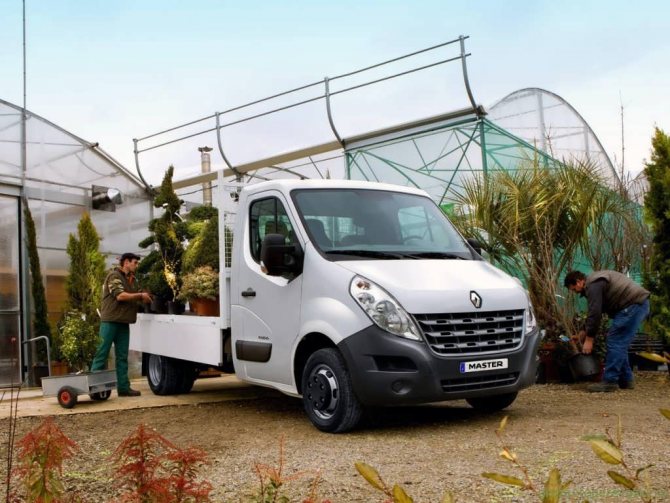
Renault Master "pickup" after the 2010 update.
Maximum load from 909 to 1609 kg depending on the configuration. The maximum trailer weight with brakes is 2.5 tons, without brakes - 800 kg. Only a manual transmission (6 speed) is offered. Reviews of Renault Master speak about the high driving stability and high maneuverability of the vehicle. The turning radius is 12.2 meters. The front suspension is designed using upper reaction rod from two levers. This design has a wide profile, which allows you to control the movement of the car on wet roads. The front wheels have independent suspension.
Options and prices “Renault Master”
- Short wheelbase with front-wheel drive and low body - 998 thousand rubles;
- Front-wheel drive medium body - 1094 thousand rubles;
- Front-wheel drive body of medium length, but with a high roof - 1130 thousand rubles;
- Front-wheel drive long body with a medium-height roof - 1136 thousand rubles;
- Front-wheel drive car with a long and high body - 1171 thousand rubles;
- The same body with rear-wheel drive - 1304 thousand rubles;
- Maximum configuration - rear-wheel drive with a large body and increased overhang - 1335 thousand rubles.
A driver's airbag is standard, but you'll have to pay extra for passenger safety. The ESP system is installed only on “maximum” trim levels, as is the power take-off on the box (35 thousand). Locking the rear differential is possible only on front-wheel drive, it costs 35 thousand. An on-board computer with a Russian-language interface is included in the price of all “kits”. For 20 thousand you can install an additional sliding door on both the right and left. In any case, you will have to buy an air conditioner (35 thousand), as well as an mp3/cd player (9900 rubles).
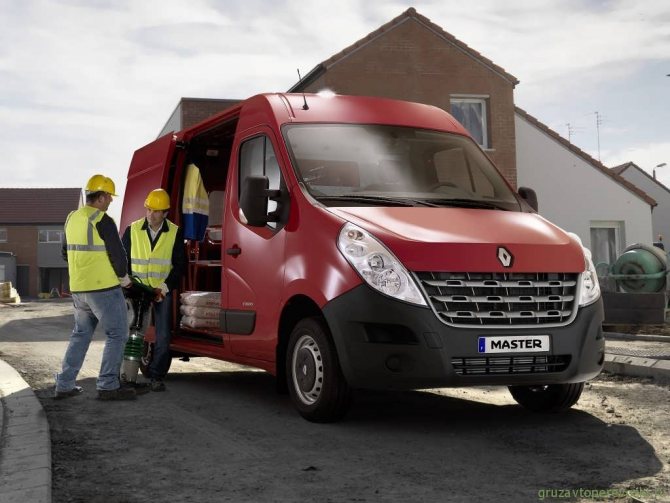
The versatility of the Renault Master is confirmed by any configuration, but an additional door costs money.
Reviews “Renault Master”
Alexey, Moscow. Car: Renault Master 2014.
On all points I can give the car 10 points. Perhaps the fact is that this is my first diesel Van. Before choosing a car, I ranked the vans according to popularity and the Renault Master ended up only in fourth place behind the Iveco Delhi, Mercedes Sprinters, Fiat Ducato and Peugeot Boxer. However, for various reasons (maintenance cost, availability of spare parts, rear-wheel drive (!) and build quality). The Sprinter is good for everyone, but in Russia Mercedes is currently only assembling the previous model. I had to be convinced of the quality of Iveco with a minus sign, but the joint development of the middling Opel, Nissan and Renault captivated me with its average confidence and focus. Good visibility, comfortable, spacious interior, competent arrangement of all parts. During the entire period of operation (300 km of run) I did not find any serious flaws. The only thing is that the driver's seat is a little short - you slide out a little.
Interior
In a commercial vehicle, the interior is not the most important thing, but here everything is carefully thought out. The driver will feel very comfortable in the cabin. There are many different compartments for small items, storage for food, as well as documentation.
The car has excellent visibility through all windows. The steering wheel can be adjusted in height - you can choose the most optimal position. All Renault Master configurations are equipped with power steering - you don’t have to make any effort to control it.
It is necessary to say about the seats - the driver’s seat is made in such a way as to minimize vibrations and vibrations, regardless of the driver’s weight. When driving this car over a speed bump, you may not even feel it. Even in a simple configuration, the chair is height adjustable.
Power section
Any version is equipped with a 2.3-liter diesel engine. There are three engines to choose from, ranging from 100 to 150 horsepower. These engines are a logical continuation of the MR development by Nissan. But these engines are installed only on truck models. Any version of the Renault Master engine has acceptable consumption and complies with environmental requirements (in this case Euro-4). There are models with and without Common Rail. All engines are in-line, four-cylinder. The 100 horsepower version of the engine has a torque of 248 Nm. The 125 horsepower version has a torque of 310 Nm. The 150 horsepower version has a torque of 350 Nm.
Suspension
The design of the front suspension is based on a reaction rod, which connects two arms. This scheme allows you to accurately control the car on wet surfaces. The type of front suspension itself is independent.
The latest generation cars are equipped with suspension and chassis that are distinguished by high performance in terms of directional stability. Additionally, you can control handling on any surface due to the wide track. The suspension works in such a way that its stability does not depend on the vehicle's load. The rear suspension is a trailing arm.
What affects high fuel costs?
In general, the difficulties and reasons for the increase in fuel consumption by the Renault Duster model car are divided into two groups: general (related to driving and car parts) and weather-related (which include, first of all, problems of the winter season).
Common reasons for volumetric gasoline consumption
The main enemy of Duster car owners is city driving. It is here that the fuel consumption of the engine increases significantly.
Accelerating and braking at traffic lights, changing the car to another lane, and even parking “force” the engine to consume more fuel.
But there are other factors that influence the increase in fuel consumption:
- fuel quality;
- problems with the transmission or chassis of the vehicle;
- degree of engine wear;
- tire type and tire pressure changes;
- equipment of the car with manual or automatic transmissions;
- use of all-wheel drive, front-wheel drive or rear-wheel drive in a car;
- terrain and quality of road surface;
- driving style;
- use of climate control devices.
Weather factors increase fuel costs
Driving in winter has many disadvantages. There are many reviews on the Internet from owners of similar cars, and the same number of reviews about winter driving problems:
- slippery road surfaces;
- warming up the engine, car interior and tires;
- An automatic transmission increases the engine's fuel consumption.
History of the model
The Renault Master modification, created back in 1980, was developed for several years and immediately gained popularity. During this time, three generations of similar machines were released on the world market. The second and third generations were presented in Europe and the UK under the names Opel Movano, Nissan NV400 and Vauxhall Movano. When restrictions were introduced on the tonnage of vehicles, the need for these vehicles increased sharply.
Car modifications
Renault Master is produced in various versions:
- standard van with increased height or long wheelbase;
- passenger modification, including minibuses and buses;
- chassis.
The most popular was the cargo van, designed for transporting goods around the city and its environs.
The first generation of the car was produced for 17 years. During this time, in addition to the diesel engine, which had a volume of 2.4 liters, an engine with a capacity of 2.1 liters appeared, and later gasoline units with a volume of 2 and 2.2 liters appeared. At that time, the appearance of the Renault Master was the most ordinary. The angular shapes, design of the headlights and radiator grille were not attractive.
Until 2010, the company produced the following family of vans. They were equipped with power units with a volume of 2.2, 2.5 or 2.8 liters. As a result of restyling carried out in 2003, the appearance of the Renault Master II was significantly transformed. Mainly due to the rounded contours of the body, large headlights and bumper.
The design of the Renault Master III has been significantly revised. The front part with clear lines, a massive bumper, and drop-shaped headlights gave the car individual features. The volume of the cargo compartment has been increased. Loading and unloading has been made significantly easier by optimizing the thresholds. The range of engines was expanded to include engines with power from 100 to 150 horsepower.
In 2020, a modification of the Renault Master X-Track was introduced, which increased ground clearance, provided underbody protection and a limited-slip differential. Another new product is the all-wheel drive Renault Master 4×4.
Renault Master second generation
Renault Master vans of the second generation were equipped with Renault and Nissan diesel engines of the following types:
- volume 1.9 l, power 82 hp.
- volume 2.2 l, power 90 hp.
- volume 2.5 l, power 80 hp.
- volume 2.8 l, power 115 hp.
Reviews of the actual consumption of Renault Master 2
- Andrey, Kerch. I bought diesel for the first time and chose among several brands. As a result, I bought a Renault Master 2008, 2.5 engine, 120 horsepower. I didn’t expect such cheerfulness and a smooth ride even on our roads. I was pleased with the cargo compartment, it is simply huge. I've been driving cargo for 2 years now without any problems. Fuel consumption varies - from 9 to 25 liters, depending on the speed.
- Sergey, Vladivostok. I am the owner of a Renault minivan 2003, 2.5-liter engine. I don't like the car, but there is no way to change it yet. Tired of frequent breakdowns, almost always sudden. True, the consumption is not bad - 8-10 liters, but that’s if you don’t drive it.
- Victor, Samara. I bought it from a Master ad, the car was in good condition. I didn’t expect to like it so much, the family is also happy. The engine is playful, small potholes are not felt at all, the high seating position is also a plus. Consumption ranges from 6 liters on the highway to 8 liters in the city, I think it’s very economical.
- Peter, Moscow. Before buying the Renault Master, I owned various vans and minivans, so I have something to compare with. The car is fire! It practically does not break down, and if you need to change some consumables, then everything is at a very affordable price. And it consumes surprisingly little fuel - 7 liters on the highway and 11 liters in the city, and that’s only because I’m a fan of fast driving.
- Ilya, St. Petersburg. I have a minivan produced in 2006, 2.5 liter engine, 88 “horses”. I am glad that original spare parts are available at a low price. But, given that there have been no serious breakdowns in two years of operation, I only make small replacements. Fuel consumption is about 7 liters outside the city.
- Alexey, Orenburg. Six months ago I bought a Renault Master 2004 from the first owner, and so far I am very pleased with the purchase. The car was kept in good conditions, so I got it like new. It consumes fuel, as promised, from 8 to 10 liters per hundred km.
- Robert, Kemerovo. At first I doubted the French technology, then I thought that it was all for work, and agreed to purchase. I purchased a Renault Master with a 2.5 liter engine, produced in 2206. The car is roomy, comfortable, starts in any weather, and is always warm inside in winter. Fuel consumption is also excellent - an average of about 9 liters per hundred.
Car device
The Renault Master van is equipped with a six-speed manual transmission, front-wheel drive or rear-wheel drive. Speeds switch clearly and silently. The car has excellent acceleration dynamics. Front independent suspension, manufactured by McPherson, and rear dependent suspension are installed. According to driver reviews, the braking system is of high quality and consists of disc brakes, the front ones are equipped with ventilation. The car is equipped with hydraulic power steering.
The car's cabin is a combination of comfort and ergonomics, and the capacity of the cargo compartment is a big advantage of the brand. The manufacturer provides a 6-year warranty against through body corrosion.
The developers have created an excellent overview for the driver of the Renault Master van. The steering wheel and seat are adjustable, and the design of the chair perfectly dampens vibrations and vibrations that occur when driving.
The protection of the driver and passengers is ensured by:
- passive system
consisting of airbags and seat belts; - Hill Start Assist
, which creates additional braking force that holds the Renault Master when stopping or parking on inclines; - ESP
, which provides insurance during turns at high speed; - ABS
, which allows you to maintain control of the vehicle during emergency braking.
Device
The range of commercial vehicles particularly clearly reflects the corporate style of the French brand. Renault Master is a clear confirmation of this. The car body, which is both practical and high-quality, is distinguished by a large decorative grille that adds individuality to the model. Side protection and a large front bumper make movement safer. French assembly guarantees the highest quality of all components. The model is distinguished by low operating costs. External elements (doors, hood and others) have a long service life. It is no coincidence that the manufacturer provides a guarantee against through corrosion for 6 years. One of the components of durability is the decorative coating of the body.
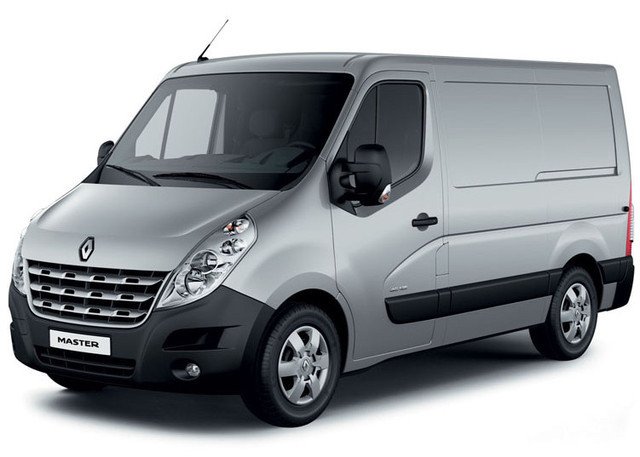
The front suspension for the model was designed using an upper reaction rod from 2 levers. This design has a wide profile that allows you to control the movement of the car on wet roads. The front wheels are equipped with independent suspension. The latest generation Renault Master is equipped with a suspension and chassis that are known for excellent directional stability. The wide track provides additional control on any type of surface. Regardless of the load, stable operation of the suspension is maintained. The rear suspension is based on a trailing arm.
The Renault Master brake system is distinguished by its increased efficiency. Ventilated disc brakes are used at the front and disc brakes at the rear.
Front- and rear-wheel drive versions of the car are available on the Russian market. The transmission option is a 6-speed manual gearbox. The sixth speed improves the fuel consumption characteristics of the machine and increases the acoustic comfort inside. The gear shift lever stroke in the Renault Master III has become shorter and the shift force has become less. At the same time, all gears are switched extremely clearly. By revising the ratio of gear ratios in the gearbox, the acceleration dynamics of the car have increased.
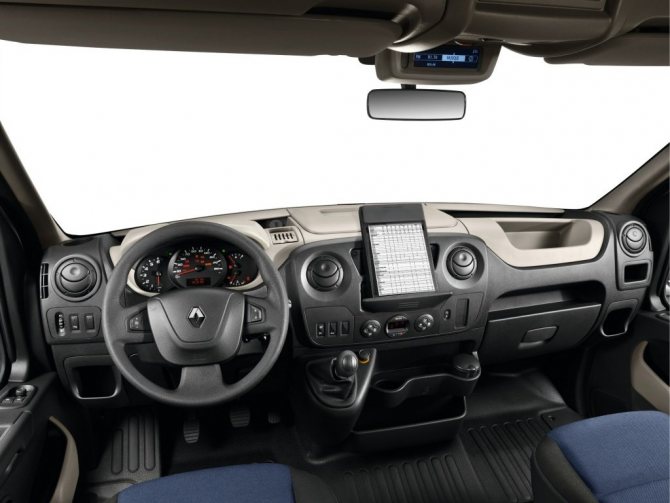
Inside, the latest Renault Master is an incredibly well-thought-out product. The cabin has a lot of storage for items of various purposes and sizes. There are pockets for small items and capacious niches for documents. This allows the driver or forwarder to pack everything they need. Visibility to the sides and through the windshield is excellent. In addition, the driver can adjust the steering wheel height, choosing the optimal position. The hydraulic booster allows you to avoid making additional efforts while driving. The seats deserve special attention. The driver's seat effectively minimizes oscillations and vibrations regardless of the person's weight. Speed bumps are practically not felt on it. Height adjustment and lumbar support are also available (already in the basic version).
Renault Master III is smartly made and looks more like an expensive long-distance truck than a delivery van intended for the city and its environs.
Description of technical parameters
The technical characteristics of Renault Master allow the car to be popular among consumers. It is quite competitive in the commercial vehicle market, reliable and easy to maintain.
The Renault Master is characterized by:
- dimensions:
5.548 x 2.07 x 2.486 m; - ground clearance:
18.5 cm; - wheelbase:
3.682 m; - loading height:
0.548 m; - turning radius:
7.05 m; - load capacity:
1.498 kg; - cargo compartment size:
3.083 x 1.765 x 1.894 m; - car body volume:
10.3 m 3 ; - number of seats Renault Master:
3; - tires:
225/65 R16.
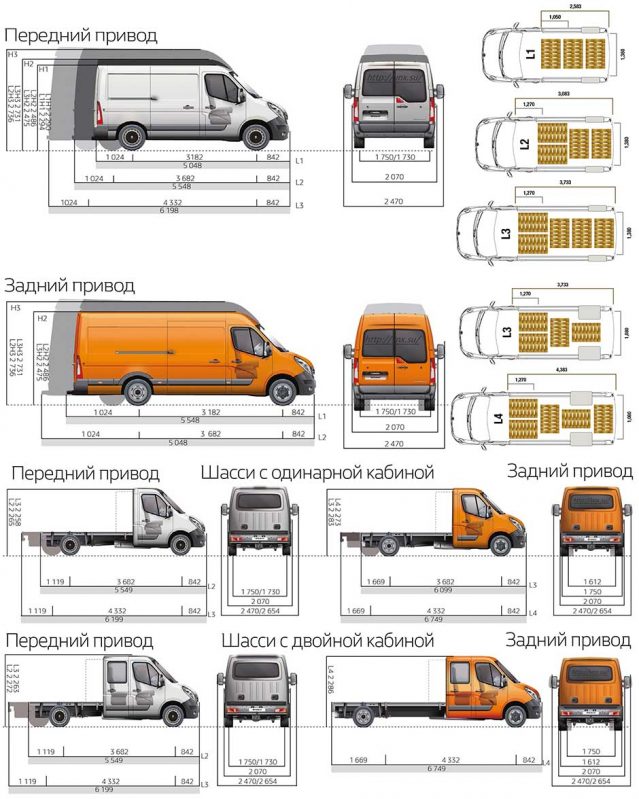
Renault Master
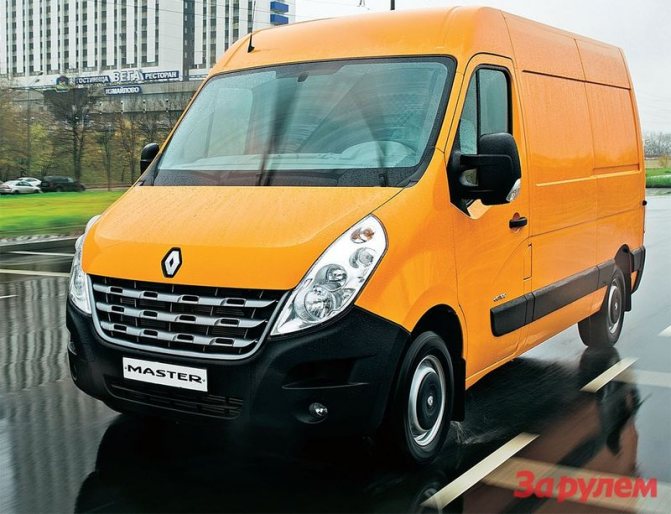
Renault Master
My first acquaintance with Renault Master took place in the 80s, when I worked at the RAF minibus plant in Riga. Then the passenger version of the minibus was purchased as an example of foreign technology worthy of imitation. I remember we were amazed by the layout of the transmission: the gearbox was in front of the engine mounted longitudinally, front-wheel drive.
Van powertrain
The Renault Master is equipped with a four-cylinder, sixteen-valve MR engine from Nissan, with an in-line arrangement of cylinders, having direct injection and supercharging.
The Renault Master engine has:
- volume 2.3 l;
- power 100–150 hp With.;
- torque (maximum) 248–350 N/m;
- environmental class Euro 4.
Those interested are offered cars in which the Common Rail system is installed.
French specialists have long ago created the Renault Master light-duty car. The start of production of the first version of the car occurred in 1980. The Renault company in Russia produces the third generation of cars.
New Renault Master multifunctional transport. Manufacturers produce the car in several body styles:
- vans;
- passenger options;
- chassis.
The most common version is the cargo version. This car is unique in its spaciousness.
The modern and stylish design of the Renault Master vehicle emphasizes the quality and superiority of technical characteristics.
Exterior
The third generation of the Renault Master car on the Russian market is presented in an updated version. The changes affected the headlights. These elements have become elongated. As for the radiator grille, it has become wider. Modified wheel arches give the vehicle a massive appearance.
The asymmetrical windows of the rear doors add originality to the design of the vehicle. Volumetric moldings. And the door handles have become more comfortable and convenient.
For safe movement, the creators installed additional cornering lights. They turn on when you turn the steering wheel. A blind spot mirror is also installed. Therefore, the driver controls the situation in the event of a complex maneuver.
Interior
The interior of the Renault Master, as can be seen from the photo, is stylish, modern and comfortable. The driver's seat is height adjustable. A comfortable armrest ensures comfortable control of the machine, especially when traveling over long distances.
The updated Renault also features air conditioning. This element is capable of maintaining an acceptable temperature in the cabin.
For a pleasant trip, the car is equipped with a CD-MP3 audio system. The interface includes Bluetooth, USB and AUX. And also cruise control. This element saves fuel and effort when traveling long distances.
The salon is equipped with a spacious compartment for storing personal belongings. And when installing an air conditioner, this place turns into a cooled compartment. The middle seat transforms into a comfortable table. The chair can also be simply folded for convenience.
The center console has compartments for storing small items. And for a mobile phone, manufacturers installed a specialized compartment. Now the driver no longer has to look for his phone throughout the cabin.
Options and prices
The Renault Master vehicle is available in several body styles. The most common is the cargo van.
Options and prices of Renault Master 2020 model year.
- Fourgon L1 H1 FWD. The volume is 2.3 liters, power 125 hp. Price – 1 million 660 thousand rubles.
- Fourgon L2 H2 FWD. The volume is 2.3 liters, power 125 hp. Price – 1 million 700 thousand rubles.
- Fourgon L2 H3 FWD. The volume is 2.3 liters, power 125 hp. Price – 1 million 750 thousand rubles.
- Fourgon L3 H2 FWD. The volume is 2.3 liters, power 125 hp. Price – 1 million 760 thousand rubles.
- Fourgon L3 H3 FWD. The volume is 2.3 liters, power 125 hp. Price – 1 million 800 thousand rubles.
- Fourgon L3 H2 RWD. The volume is 2.3 liters, power 125 hp. Price – 1 million 950 thousand rubles.
- Fourgon L4 H3 RWD. The volume is 2.3 liters, power 150 hp. Price – 2 million 100 thousand rubles.
All options are equipped with a manual gearbox.
The cargo-passenger Renault Master is one of the most affordable vehicles in Russia.
In addition, the car is suitable for passenger transportation due to its comfortable interior design.
Fuel consumption
According to official sources of Renault, fuel consumption standards for Renault Duster per 100 km look more than acceptable. And real fuel consumption figures do not differ much from passport information. In general, the Renault Duster SUV is presented in several modifications, which are described below
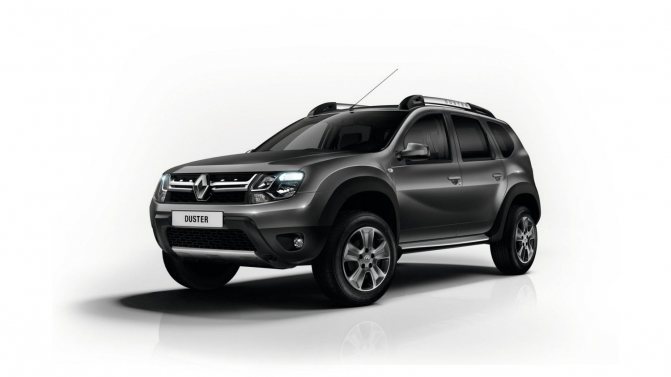
Consumption on a 1.5 liter diesel engine
The first model presented in this series of cars is the 1.5 dCi diesel. Technical characteristics of this type of Renault Duster: power 109 horsepower, speed – 156 km/h, equipped with a new injection system. And Renault Duster gasoline consumption per 100 km is 5.9 liters (in the city), 5 liters (on the highway) and 5.3 liters in the combined cycle
. Fuel consumption in winter increases to 7.1 (in the variable cycle) -7.7 liters (in the city).
Gasoline consumption on a 1.6 liter engine
The next one is a crossover with a gasoline engine, its cylinder capacity is 1.6 liters, power is 114 horses, and the possible speed that the car develops is 158 km/h. The fuel consumption of a Duster of this type of engine is 7 liters outside the city, 11 liters in the city and 8.3 liters in the combined cycle per 100 kilometers.
In winter, the numbers are a little different: 10 liters of gasoline costs on the highway, 12-13 liters in the city.
Costs of a 2.0 engine with manual and automatic transmission
The lineup is completed by an SUV with a 2-liter engine. It is worth noting that it is equipped with an increased efficiency mode, which makes this model better than the previous one. Engine power is 135 horsepower, speed is 177 km/h. At the same time, Renault Duster fuel consumption is 10.3 liters in the city cycle, 7.8 liters in the mixed cycle and 6.5 liters in the extra-urban cycle.
. In winter, city driving will cost 11 liters, and on the highway - 8.5 liters per 100 km.
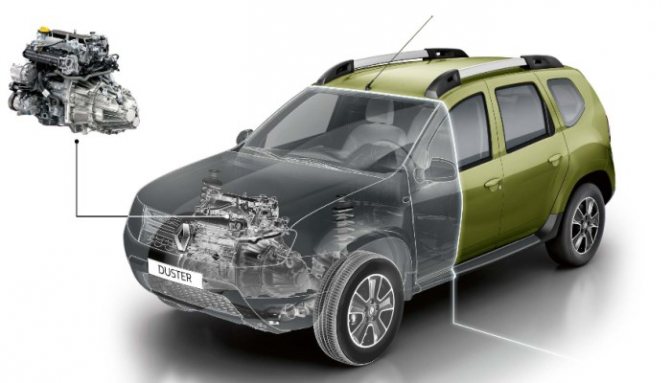
2015 was a turning point for the Renault Duster crossover line. Renault Group has released an improved version of the SUV with a 2-liter engine. The predecessor was equipped with a manual transmission and gasoline costs were higher. Average gasoline consumption for a Renault Duster with an automatic transmission is 10.3 liters, 7.8 liters and 6.5 liters, respectively (in the city, variable speed and on the highway), engine power is 143 horses. The winter period will cost 1.5 liters more per 100 kilometers.
